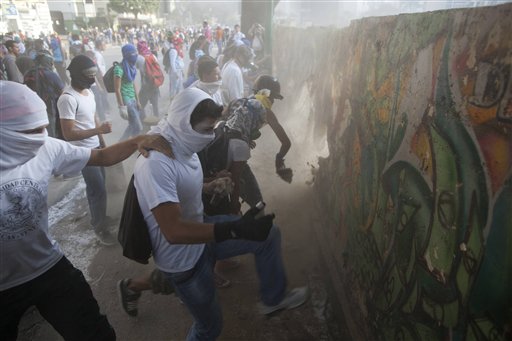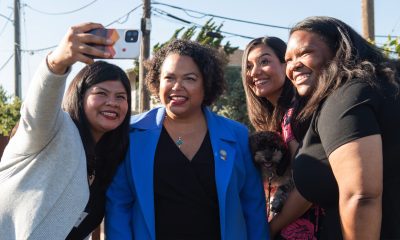World
Venezuela’s Chavez Everywhere A Year After Death


Demonstrators destroy a wall in order to have more rocks to throw at the Bolivarian National Guard during anti-government protests in Caracas, Venezuela, Tuesday, March 4, 2014. A year after the death of Hugo Chavez, Venezuela has been rocked by weeks of violent protests that the government says have left 18 dead. (AP Photo/Rodrigo Abd)
CHRISTOPHER SHERMAN, Associated Press
EZEQUIEL ABIU LOPEZ, Associated Press
CARACAS, Venezuela (AP) — It’s been a year since former Venezuelan President Hugo Chavez’s death, yet it often seems the charismatic leader never left.
Chavez’s portrait in a red beret is still seen on buildings, pins, action-figure dolls and daily on television. National guard troops have used a recording of Chavez reciting poetry played at high volume to disperse protesters in Caracas. Even when the Chavez highlight reel isn’t playing, President Nicolas Maduro has been known to say he’s spotted the man who hand-picked him to lead the country in a little bird or a subway tunnel’s rock wall.
Wednesday’s anniversary of Chavez’s death follows weeks of sometimes violent protests that the government says have left 18 dead. Maduro appears ready to use Chavez’s almost mythical status to steady his rule as protesters refuse to leave the streets.
Last week, Maduro announced 10 days of commemoration beginning Wednesday morning with a military parade in Caracas followed by a remembrance ceremony at Chavez’s mausoleum and capped with the debut of director Oliver Stone’s documentary “My Friend Hugo.”
On Tuesday, workers for the state oil company were putting a fresh coat of paint on Chavez’s mausoleum in preparation for those expected to flock to the site.
“For me, he was something great,” said Felida Mora, who travels about 20 miles (more than 30 kilometers) to Caracas from Los Teques at least once a month to pray nearby at an improvised tin-roof St. Hugo Chavez Chapel in the 23rd of January slum.
The small structure is painted red and white and contains a plaster bust of Chavez beneath a poster of the departed leader and Jesus Christ. On the bust is written: “You were, you are and you will be eternally our giant; we will always love you.”
“I have cried a lot for him, more than for my family,” Mora said.
Chavez died on March 5, 2013, after a long battle with cancer. He chose Maduro, a former bus driver and union leader to be his successor, but the ride since his death has been anything but smooth. Inflation hit 56 percent last year, there are shortages of basic commodities such as cooking oil and flour and one of the highest murder rates in the world keeps people locked inside their homes at night.
Venezuela has been shaken by nearly a month of protests that have now settled into a pattern: Thousands march peacefully through the streets by day, but as night falls smaller groups confront authorities who respond with tear gas and rubber bullets.
Chavez’s visage can be found in almost any corner of the capital and portraits of Chavez abound in the countryside as well: the leader wearing a farmer’s sombrero, alongside soldiers in his red beret or greeting children or the elderly.
Maduro often calls himself the son of Chavez and when he makes speeches, there’s often a photo of Chavez somewhere in the frame. The tourism ministry released a short video homage to Chavez — tweeted Tuesday by Maduro — crediting him with marking the start of Venezuelan tourism and teaching Venezuelans to love their country.
At 6 a.m. every day, Venezuelans can tune in to state television to hear Chavez sing the national anthem. The same channel plays reruns of his television show, “Hello President,” on the weekends. There was a cartoon that portrayed Chavez meeting other historic figures in heaven.
“Maduro, even though he was hand-picked by Chavez, he doesn’t have the charisma, the ability to engage audiences with him that Chavez had,” said Carolina Acosta-Alzuru, a Caracas native who is an associate professor of media studies at the University of Georgia. “So he repeats, invokes Chavez, calls himself the son of Chavez as much as he can.”
Copyright 2014 The Associated Press. All rights reserved. This material may not be published, broadcast, rewritten or redistributed.








































